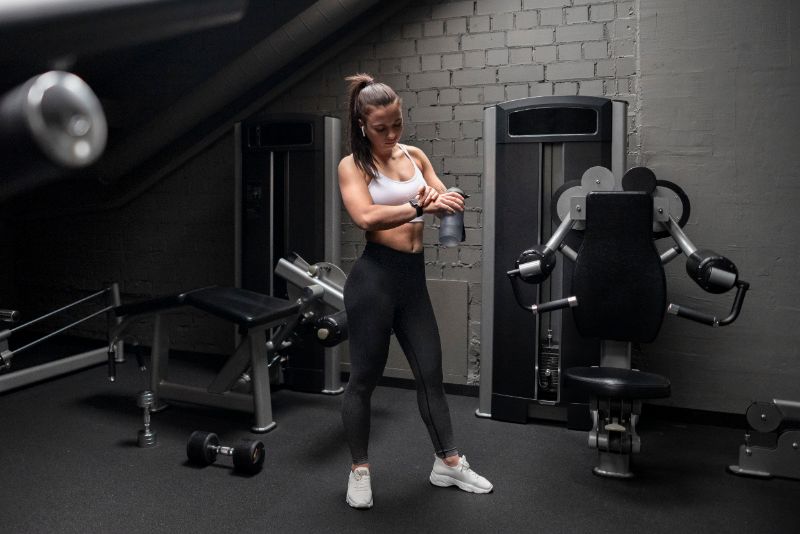After undergoing a Botox treatment, it is advisable to modify your exercise regimen, at least temporarily. Engaging in physical activity immediately after receiving Botox injections may potentially affect the outcome of the treatment. This is because intense movements or increased blood flow can cause the Botox to spread to unintended areas, which may reduce its effectiveness or alter its intended effects.
It is generally recommended to avoid strenuous exercise for at least 24 hours post-treatment. This precaution helps ensure that the Botox remains localized to the targeted muscles and has sufficient time to settle. Activities such as running, weight lifting, or any form of high-intensity workout should be avoided during this period.
After the initial 24-hour period, you can gradually resume your exercise routine. However, it is wise to start with less intense activities and closely monitor any unusual sensations or changes in the treated areas. If you experience any unexpected side effects, it is important to consult with your healthcare provider.
In conclusion, while maintaining an active lifestyle is important, taking a short break from intense physical activities after a Botox treatment can contribute to the effectiveness and safety of the procedure. It is always best to follow the specific guidelines provided by your healthcare practitioner.
Understanding Botox and Exercise
To understand the interaction between Botox and physical activity, it’s important to recognize that vigorous exercise may potentially cause Botox to disperse from the targeted area due to increased circulation. Following Botox injections, it’s advisable to avoid actions that involve significant movement or pressure on the face, such as bending over. This precaution helps to minimize the risk of Botox migrating from its intended site, which could compromise the effectiveness of the treatment.
Some studies suggest that engaging in mild facial movements like smiling or frowning shortly after receiving Botox might facilitate quicker results by helping the product integrate into the muscle. However, it’s generally recommended to refrain from intense physical activities for at least 24 hours post-injection to ensure the Botox remains stable and effective.
Maintaining a gentle approach to facial expressions and avoiding direct pressure on the areas treated with Botox are key factors in achieving the desired outcome without unintended side effects. It’s crucial to balance activity post-Botox to maintain the integrity of the results.
Immediate After-Effects of Botox
Following a Botox injection, patients may experience common side effects such as redness, swelling, or bruising at the injection site. These reactions are typically mild and tend to resolve independently over time.
Botox functions by inhibiting nerve signals in the targeted muscles, leading to a temporary reduction in muscle activity, which helps in the reduction of appearance of wrinkles.
It is advisable to refrain from engaging in vigorous physical activities immediately after receiving Botox treatments. Such activities could potentially cause the product to disperse to unintended areas, which might reduce its efficacy in the targeted regions.
Light activities, such as walking or gentle yoga, are preferable during the initial hours following the procedure.
Patients are encouraged to follow their healthcare provider’s instructions regarding post-injection care. Adhering to these guidelines is essential for ensuring the effectiveness of the treatment and minimizing any adverse effects.
Proper aftercare supports the intended outcomes of the Botox treatment.
The 24-Hour Post-Botox Rule
The 24-hour post-Botox rule is a standard recommendation from healthcare professionals who advise patients to refrain from engaging in strenuous physical activities for a full day following a Botox injection. The primary reason for this guidance is to allow the Botox to stabilize within the targeted muscles.
Increased blood flow, which can occur during intense physical exercise, might cause the Botox to disperse away from the intended areas, potentially diminishing the effectiveness of the treatment and altering its cosmetic outcomes.
It is generally considered acceptable for patients to engage in light activities a few hours post-treatment; however, activities that elevate the heart rate significantly should be avoided for at least 24 hours.
Adhering to this precaution helps ensure that the administered Botox remains concentrated at the injection sites, thereby maximizing the treatment’s efficacy and reducing the likelihood of side effects.
This protocol is supported by clinical understanding of Botox’s mechanism within the neuromuscular junction and its interaction with body dynamics during physical exertion.
Potential Risks of Early Exercise
Exercising shortly after receiving Botox injections can lead to several complications, such as increased swelling and bruising, as well as potentially reducing the effectiveness of the treatment.
Engaging in vigorous activities immediately after treatment can elevate blood pressure and enhance blood flow, which may result in the unintended dispersal of Botox from the injected sites. Such migration can interfere with the intended effects of the treatment, as the neurotoxin requires time to stabilize within the targeted muscles.
Physical exercises that involve significant facial movements or pressure, such as running or jumping, might also disrupt the process of muscle relaxation that Botox is designed to induce.
To optimize the results of a Botox treatment, medical professionals generally advise patients to avoid strenuous physical activities for at least 24 hours post-injection.
Safe Activities After Botox
Following Botox treatment, it’s advisable to engage in low-intensity activities that don’t exert significant pressure on the treated areas. Walking at a relaxed pace, performing light household chores, and participating in gentle yoga that avoids poses which invert the body, can be beneficial. These activities contribute to maintaining overall health without compromising the effectiveness of the Botox treatment.
It is also recommended to perform facial exercises as directed by your healthcare provider. These exercises can potentially aid in the more efficient absorption of Botox, although it’s essential to follow the specific guidance provided to avoid any negative impact on the treatment outcome.
Avoiding vigorous physical activities for at least 24 hours post-treatment is crucial to prevent the migration of Botox from the targeted areas, which could reduce its effectiveness. Adhering to post-treatment instructions provided by your healthcare professional is essential to ensure optimal results from the Botox treatment.
Maintaining a balance between rest and activity post-Botox is important. While it’s necessary to avoid strenuous exercise immediately following the treatment, remaining lightly active is beneficial for overall well-being.
Exercises to Avoid Post-Botox
Post-Botox, it’s advisable to engage in only mild activity to ensure the treatment remains effective and to avoid complications. Activities that exert pressure on the injection site are particularly risky. Pressure can increase the likelihood of bruising and might cause the Botox to disperse to areas not intended for treatment. Such activities include intense facial expressions, bending over, lying on your face, or performing any movement that inverts the body.
Additionally, swimming with goggles that fit tightly or wearing snug headgear can also apply pressure that may affect the Botox’s placement and effectiveness. Plastic surgeons generally recommend avoiding these specific activities to support optimal treatment outcomes. Following these guidelines can help maintain the integrity of the Botox application and contribute to lasting results.
Benefits of Facial Exercise
While incorporating facial exercises into your routine after Botox treatments is sometimes suggested, it’s important to approach this with caution. Research, including studies published in the Journal of the American Academy of Dermatology, provides mixed evidence on the benefits of facial exercises in conjunction with Botox.
Some theories suggest that these exercises might help improve muscle tone and skin elasticity, potentially prolonging the effects of Botox. However, there’s no definitive evidence that supports these claims conclusively.
If you’re considering adding facial exercises to your post-Botox regimen, it’s crucial to first consult with your healthcare provider. They can offer guidance tailored to your specific circumstances and treatment plan. This step ensures that any additional activities don’t interfere with the results of your Botox injections.
When to Consult a Doctor
If you experience increased bruising, swelling, or pain after engaging in physical activities post-Botox treatment, it’s advisable to consult a healthcare professional. These symptoms could indicate an adverse reaction to the treatment.
Additionally, if symptoms such as dizziness, muscle weakness, or blurry vision persist or worsen, medical advice should be sought. It’s recommended to avoid strenuous exercise immediately after Botox injections to prevent discomfort or exacerbation of side effects.
Immediate medical attention should be sought for severe reactions like significant swelling or difficulty breathing, as these may represent serious complications. It’s prudent to contact a healthcare provider with any concerns following a Botox procedure to ensure safety and proper care.
Maximizing Botox Results
To optimize the effectiveness of Botox treatments, adhering to post-treatment guidelines provided by healthcare professionals is essential. It’s generally advised to allow for a period of rest following the procedure, typically around 24 hours, to minimize any potential disturbances to the treatment area.
Engaging in high-intensity physical activities immediately after receiving Botox injections isn’t recommended, as it may increase the risk of spreading the toxin to unintended areas, potentially diminishing the desired effects.
Light physical activities, such as walking or gentle yoga, may be beneficial after this initial rest period. These activities can promote blood circulation without exerting excessive stress on the facial muscles.
Incorporating facial exercises post-treatment can also be beneficial. These exercises might help to evenly distribute the Botox within the treated muscles. However, it’s important to follow specific instructions from your healthcare provider regarding the type and frequency of facial exercises recommended, as improper techniques may interfere with the outcome of the treatment.
Conclusion
Following a Botox procedure, it’s generally recommended to avoid engaging in strenuous physical activities for at least 24 hours. This precaution is advised to prevent the spread of the toxin to unintended areas, which could potentially alter the intended effects of the treatment.
Activities considered light, such as walking or gentle yoga, are typically deemed safe and may be undertaken shortly after the procedure. However, it’s important to adhere to the specific guidance provided by your healthcare provider regarding post-treatment care.
Consulting a healthcare professional is advisable if any unusual symptoms occur after the procedure. By following these guidelines, patients are more likely to achieve the desired outcomes from their Botox treatment.
Related articles:


